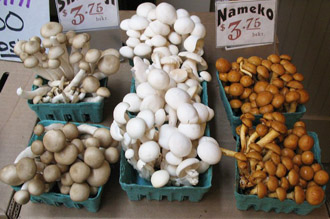Edible mushrooms
Out of the vast array of fungal genera, just a few can be grown as edible mushrooms. However, before delving into that, let's begin by understanding the essence of mushrooms.
To put it simply, mushrooms are multicellular fungi. From a biological standpoint, they represent soft, fleshy protrusions of hyphae or mycelia that emerge above the surface.
 |
| Edible mushrooms. Photo courtesy: Gary Stevens |
Within the realm of living organisms, mushrooms fall into a distinct kingdom separate from plants and animals. They do not possess chlorophyll, and as a result, they are unable to produce their own sustenance, relying instead on pre-existing organic materials for their growth.
Mushrooms exhibit a wide array of shapes and appearances. Typically, they consist of a cap and a stalk and are commonly found on decomposing organic matter such as manure, wood, humus, or any decaying substance. Their lack of chlorophyll pigment gives them a variety of colors, often appearing in shades of white, brown, or even dark hues like truffles.
Typically, edible mushrooms fall into two categories: domestic and wild.
Domestic mushrooms are cultivated under controlled conditions and are sold through reputable retailers. On the other hand, wild mushrooms are naturally occurring in forests and fields. These are usually gathered from the wild and may be limited for personal use or shared among friends and family.
Classification of edible mushrooms
Edible fungi occur in two major taxonomic groups.
The basidiomycetes include the mushrooms, shelf (bracket) fungi, and bolete;
The ascomycetes include truffles and morels.
Here is an impressive list of edible mushrooms with detailed illustrations of their health benefits and nutrition facts:
Health Benefits of Mushroom Nutrition
Mushrooms are naturally rich in proteins, vitamins, minerals, and antioxidants.
They provide an ample supply of vitamin B-12, a nutrient that is typically lacking in most plant-based foods.
Despite their high nutritional value, mushrooms are low in calories and fats, and they contain no cholesterol.
Additionally, mushrooms contain natural antioxidants such as ergothioneine and phenolic pigments.
They are also excellent sources of essential minerals, including manganese, selenium, zinc, copper, iodine, and molybdenum.
Furthermore, mushrooms provide modest amounts of vitamin D (ergo-calciferol), which plays a crucial role in calcium and phosphate metabolism.
Choosing the right Mushrooms
While gathering wild mushrooms requires expertise, cultivated mushrooms are accessible to everyone and can be found in most grocery stores throughout the season. Look for mushrooms that appear fresh and firm. Avoid those that are dry, discolored, or shriveled, as these are signs of decay and may lack flavor. Supermarkets typically offer mushrooms in polythene-wrapped packages or canned options.
Mushrooms are highly perishable, so handle them with care. Use them as soon as possible once you bring them home. If you need to store them, keep the packaging sealed and store them in the refrigerator at 0-2 degrees Celsius. Loose mushrooms can be placed in a paper bag to absorb moisture before refrigerating for short-term use. Mushrooms can also be dried and stored for up to a year.
Using Edible Mushrooms: A Simple Guide
If you plan to incorporate edible mushrooms into your cooking, it's important to prepare them properly. Begin by cleaning the mushrooms. To do this, gently brush them with a soft cloth or a brush to remove any small particles from their surface. If necessary, you can rinse them quickly under running water or in slightly vinegary water, but avoid soaking them. Afterward, pat them dry with a soft towel. There's no need to peel them; however, you should trim any dry or tough ends from the stems.
Unlike some vegetables, peeling mushrooms is not recommended, as it can lead to a loss of both flavor and nutritional value. In most cases, the stem (or "foot") of the mushroom is entirely edible. However, some mushroom species may have tough and fibrous stems that should be removed. For others, simply cut off the base of the stem if it appears dry or has traces of soil.
Guidelines for preparing mushrooms
Opt for stainless steel, glass, cast iron, or terra-cotta cookware when preparing mushrooms to prevent undesirable browning.
For optimal results, add salt towards the end of the cooking process to prevent mushrooms from shrinking due to water release.
To maximize their flavor, consider incorporating mushrooms towards the end of the cooking time for dishes that require extended simmering.
Note that freezing mushrooms can alter their texture and diminish their overall flavor profile.
Mushroom Toxicity: Beware of Poisonous Varieties
While a significant portion of mushrooms is deemed inedible, the truly poisonous or lethal ones constitute a relatively small fraction. Many people inadvertently gather these toxic mushrooms while foraging for wild, edible varieties in forests and fields. Distinguishing between edible and poisonous mushrooms is a challenging task, as there are no consistent features or definitive tests to rely on. The only trustworthy indicator of edibility is the knowledge that someone has safely consumed a particular type. An expert with a deep understanding of poisonous mushrooms can identify and differentiate them from their edible counterparts.
Among the most notorious poisonous species is Amanita phalloides, responsible for a significant number of mushroom-related deaths worldwide. Additionally, several mushroom varieties, while not lethal, can cause various health issues such as stomachaches and vomiting. Hence, it is crucial to accurately identify the type and edibility of any mushroom before considering consumption. (Medical disclaimer).
≻≻-Back to Home page from Edible mushrooms.
Further reading and Resources:
Stanford School of Medicine Cancer information Page- Nutrition to Reduce Cancer Risk. (Link opens in new window).




